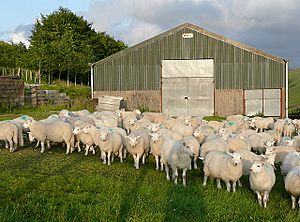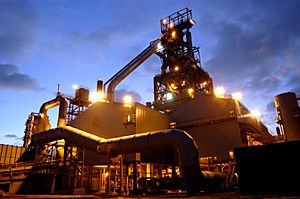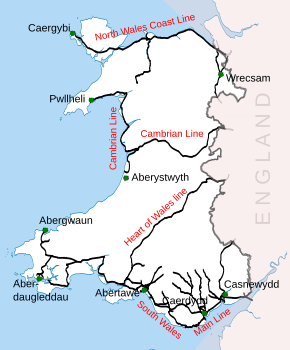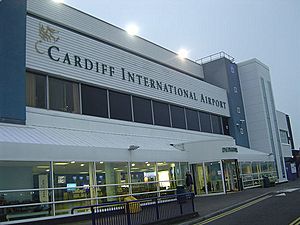Economy of Wales facts for kids
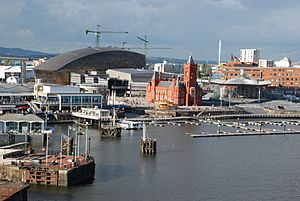
Cardiff: Wales's capital city
|
|
| Currency | Pound sterling (GBP) |
|---|---|
| Statistics | |
| GDP | |
|
GDP growth
|
|
|
GDP per capita
|
|
|
Population below poverty line
|
|
|
Labour force
|
|
| Unemployment | ▼3.9% (July 2021) |
|
Main industries
|
Agriculture, aerospace, construction, electronics, emergency services, food, forestry, manufacturing, oil and gas, renewable energy, services, textiles, tourism, transport |
| External | |
| Exports | (2019: £17.7 billion) |
|
Export goods
|
Aerospace systems, business and financial services, cereals, chemical products, dairy products, electricity, electronics, iron and steel, machinery, oil and gas, pharmaceuticals, plastics, renewable energy, road vehicles, textiles, timber, water |
|
Main export partners
|
Excluding the rest of the |
|
All values, unless otherwise stated, are in US dollars. |
|
The monetary policies which create the economy of Wales are, on the whole, created by the United Kingdom Government and as such, Wales is not allowed to borrow money, issue bonds, exercise quantitative easing etc. In 2017, the area of lowest income in Northern Europe was West Wales and the Valleys. This featured alongside nine other regions of similar income lying in England and mainland Europe.
The percentage of all individuals, living in relative income poverty in Wales in 2016–17 was 23%, compared to 22% in England, and only 19% in Scotland and Northern Ireland. More than one in five people in Wales were living in poverty between 2001 and 2016.
However, in 2018, according to OECD and Eurostat data, gross domestic product (GDP) in Wales was £75 billion, an increase of 3.3% from 2017. GDP per head in Wales in 2018 was £23,866, an increase of 2.9% on 2017. In 2019 Wales generated tax revenue of £27bn, which is around 36% of GDP, and has expenditure of £40.1bn, leaving an deficit of £13.1bn.
Contents
Economy by country and region
According to Eurostat figures there are huge regional disparities in the UK with GDP per capita ranging from €15,000 in West Wales to €179,800 in Inner-London West. There are 26 areas in the UK where the GDP per person is under €20,000.
These areas are the following:
- 4.5 million (8.5% of English) live in these deprived English districts. 11 of these deprived regions in England: Durham, Northumberland, Greater Manchester North, Blackpool, Sefton, Wirral, Barnsley Doncaster Rotherham, South Nottinghamshire, Dudley, Outer London – East North East, Torbay
- 1.4 million (45% of Welsh) live in these deprived Welsh districts. 6 of these deprived regions in Wales: Isle of Anglesey, Conwy & Denbighshire, South West Wales, Central Valleys, Gwent Valley, Powys
- 1.1 million (20% of Scottish) live in these deprived Scottish districts. 5 of these deprived regions in Scotland: Clackmannshire & Fife, East & Mid Lothian, East & West Dumbartonshire, East & North Ayrshire, Caithness Sutherland & Ross,
- 1.1 million (60% of Northern Irish) live in these deprived Northern Irish districts.3 of these in Northern Ireland: Outer Belfast, North of Northern Ireland, West & South of Northern Ireland.
Regional variations
In recent years, Cardiff, the northern and southern coastal belts and some rural parts of Wales have experienced the biggest increase in employment, while the South Wales Valleys and other industrial towns have suffered a decline. This pattern probably reflects a combination of
- the increasing importance of quality of life factors in location decisions;
- the greater role played by the largest conurbations as centres of service sector businesses and
- the effects of skill-biased technical change on the demand for labour, disadvantaging "skills poor" declining industrial districts.
Average earnings and employment vary considerably across Wales. They are both generally higher in east Wales, especially in urban areas, but lower in south west Wales and the Valleys, although earnings in Bridgend and Neath Port Talbot, which are still centres of skilled manufacturing employment, are relatively high. In north and north west Wales, earnings are low but the employment rates are above the Welsh average.
A significant part of the earnings (and value added per job) variations within Wales are due to structural factors such as economic mass and occupational mix rather than like-for-like lower pay or productivity. Cardiff, with over 400,000 people, benefits from its size, capital status, a hinterland in south east Wales and good connections to London and the M4 corridor. Cardiff is the primary location for service sector activities in Wales, with 26% of Welsh service sector output and 22% of Welsh service sector employment, compared to 19% of all employment in Wales. North east Wales benefits from proximity to Cheshire, Greater Manchester and Merseyside and there is significant cross-border commuting. The Valleys and the western areas of Wales have less economic mass and are more distant from major economic centres. These are some of the poorest regions in Europe and qualify for Objective One funding.
Many parts of Wales suffered from a continuous decline in heavy industry over the 20th century, culminating in the virtual disappearance of coal-mining in the 1980s. The demise of 'smokestack' industries left a legacy of high unemployment, and although unemployment has declined in recent years, unemployment in West Wales and the Valleys still tends to be higher than the Welsh average and economic inactivity (a form of hidden unemployment) continues to be a major problem in these areas. Merthyr Tydfil and Neath Port Talbot have some of the largest proportions of people in the UK not working due to long-term illness or disability, though some believe that in reality many people classified as "unable to work" through sickness are low-skilled workers encouraged to exit the labour market by the benefits system as well as declining demand for their skills.
The figures below for 2013 come from Eurostat and are denoted in Euros.
| Regions (NUTS3) | GDP € (2013) | GDP per capita € (2013) | GDP € (2016) | GDP per capita € (2016) |
|---|---|---|---|---|
| Isle of Anglesey | €1.167 bn | €16,700 | ||
| Gwynedd | €2.956 bn | €24,200 | ||
| Conwy & Denbighshire | €4.246 bn | €20,200 | ||
| South West Wales | €7.678 bn | €20,000 | ||
| Central Valleys | €5.939 bn | €20,100 | ||
| Gwent Valleys | €5.962 bn | €17,500 | ||
| Bridgend & Neath Port Talbot | €6.016 bn | €21,500 | ||
| Swansea | €5.532 bn | €23,100 | ||
| Monmouthshire & Newport | €6.322 bn | €26,500 | ||
| Cardiff & Vale of Glamorgan | €14.361 bn | €30,000 | ||
| Flintshire & Wrexham | €8.346 bn | €28,800 | ||
| Powys | €2.869 bn | €21,600 | ||
| TOTAL | € 71.396 bn | €23,200 | €81.683 bn | €26,200 |
The GDP per head for Wales was €23,200, which was 84% of the EU average of €26,600, whereas for the UK as a whole this figure was 118%. The region of Wales with the highest GDP per head was Cardiff & Vale of Glamorgan with 114% of the EU average, and the region with the lowest GDP per head was Isle of Anglesey with 57% of the EU average.
Sectors
Agriculture and forestry
In 2003, agriculture contributed £418 million to Welsh GVA, or 1.1% (including subsidies). 1.6m hectares (around 77% of Wales' total land area) is used for agricultural production and an estimated 57,500 people are directly employed in the sector. Farming is dominated by beef, sheep and the dairy sector, with the arable sector accounting for 10% of agricultural output. Average farm size is 30–40 hectares, small by UK standards, and dominated by family-run enterprises.
Forest and woodland makes up 14% of the land area of Wales and there are 4,000 jobs and in forest-based industries.
The Welsh fishing industry is the smallest in the UK, with about 1,000 full-time and 400 part-time fishermen. The minor role that the Welsh industry holds is largely due to its geographical isolation, weak distribution networks and the demise of the Wales distant-water fleet from the 1960s onwards.
Manufacturing
Wales has a diverse manufacturing sector. Heavy industry, once a mainstay of the Welsh economy, has largely been in decline over the past century but is still very apparent. Metal ore refining is a long established industry in Wales. As of 2007, Corus had manufacturing facilities at Port Talbot, Llanwern, Newport, Trostre, Shotton, Ammanford, Pontardulais, Tafarnaubach and Caerphilly, although only the Port Talbot Steelworks remains as a major integrated steelmaking plant. Nearly all the tinplate and much of the aluminium produced in the UK are made in Welsh plants.
Milford Haven has two oil refineries: around a fifth of United Kingdom capacity.
Wales is an important producer of automotive components: Ford has a major engine plant at Bridgend, and BorgWarner has a major components plant in Kenfig, South Wales.
Timet has a plant in Waunarlwydd, Swansea, which is one of the world's major suppliers of titanium for jet engine blades and medical applications.
During the 1980s and 1990s, a major growth sector in manufacturing was the electronics industry with over 130 North American and 35 Japanese companies establishing operations in Wales. However, this is a characteristic of a "branch factory" economy where routine production is located in one region while higher skill activities are located in another.
Major trading partners
Excluding intra UK trade, the European Union and the United States constitute the largest markets for Wales's exports. As part of the United Kingdom and the European Union, Wales fully participates in the single market and free trade area which exists across all EU member states and regions. Recently, with the high rates of growth in many emerging economies of southeast Asia and the Middle East such as China, UAE and Singapore, there has been a drive towards marketing Welsh products and manufactured goods in these countries, with China and Qatar entering the top ten destinations for Welsh exports in 2013.
| Destination | Value | ||||||
|---|---|---|---|---|---|---|---|
| Source: Welsh exports: Fourth quarter 2015 | |||||||
The total value of international exports from Wales in 2015 was estimated at £12.2 billion (2014: £13.4 billion). The top five exporting industries in 2013 were power generating machinery £4.0 billion (2013: £4.2 billion), petroleum, petroleum products & related materials £2.6 billion (2013: £3.8 billion), Iron & Steel £1.288 billion (2013: £1.3 billion), electric machinery £0.69 billion (2013: £0.7 billion), and professional and scientific services £0.346 billion (2013: £0.353 billion).
Services
In recent years, the service sector in Wales has seen above average growth; however in 2005 its share of GVA was small compared with most other regions of the UK. Wales does not have a favourable occupational structure, and a relatively high proportion of jobs are in public administration, health and education. Compared to more prosperous parts of the UK, Wales lacks high value added service sector employment in sectors such as finance, business services and research and development. This is partly due to a weaker agglomeration effect, due to the small size of towns and cities in Wales compared to some other UK regions and small countries.
Tourism
With its mountainous landscape and numerous sandy beaches, Wales attracts significant tourism. In 2002, nearly 13 million trips of one night or more were made in Wales, generating expenditure of £1.8 billion. Of these trips, 11.9 million were made by UK residents and 0.9 million by overseas visitors. Cardiff is the most popular destination for visitors to Wales, with 11.7 million visitors in 2006.
In 2014, over 10 million domestic trips of one night or more were made in Wales, generating expenditure of £1.7 billion.
| Attraction | No of Visitors | ||||||
|---|---|---|---|---|---|---|---|
| Wales Millennium Centre | |||||||
| The LC | |||||||
| St Fagans National History Museum | |||||||
| Folly Farm Adventure Park and Zoo | |||||||
| Cyfarthfa Castle Museum | |||||||
| National Museum Cardiff | |||||||
| Pembrey Country Park | |||||||
| Elan Valley Visitor Centre | 400,000 | ||||||
| Snowdon Summit Visitor Centre | 393,432 | ||||||
| Cardiff Castle | |||||||
| Source: Visits to Tourist Attractions in Wales 2014 | |||||||
Property
In November 2008, the average price of a house in Wales was £126,181, a fall of 11.7% since the previous year. The average house price in England and Wales as a whole was £161,883. In August 2008, average house prices in Wales ranged from £109,000 in Blaenau Gwent to £238,000 in Monmouthshire.
Economy by region
According to Eurostat figures there are huge regional disparities in the UK with GDP per capita ranging from €15,000 in West Wales to €179,800 in Inner-London West. There are 26 areas in the UK where the GDP per person is under €20,000.
These areas are the following:
- 4.5 million (8.5% of English) live in these deprived English districts. 11 of these deprived regions in England: Durham, Northumberland, Greater Manchester North, Blackpool, Sefton, Wirral, Barnsley Doncaster Rotherham, South Nottinghamshire, Dudley, Outer London – East North East, Torbay
- 1.4 million (45% of Welsh) live in these deprived Welsh districts. 6 of these deprived regions in Wales: Isle of Anglesey, Conwy & Denbighshire, South West Wales, Central Valleys, Gwent Valley, Powys
- 1.1 million (20% of Scottish)live in these deprived Scottish districts. 5 of these deprived regions in Scotland: Clackmannshire & Fife, East & Mid Lothian, East & West Dumbartonshire, East & North Ayrshire, Caithness Sutherland & Ross,
- 1.1 million (60% of Northern Irish) live in these deprived Northern Irish districts.3 of these in Northern Ireland: Outer Belfast, North of Northern Ireland, West & South of Northern Ireland.
Comparison with France and Ireland
In Wales, GDP per capita varies from €15,000 in Isle of Anglesey to €30,400 in Cardiff.
When compared to France, GDP per capita ranges from €18,900 in French Overseas Territories to €92,300 in Hauts-de-Seine and France has only 4 regions where GDP per capita is under €20,000. This suggests the level of social equality is much greater in France than in the UK.
When compared to the Republic Of Ireland, GDP per capita ranges from €20,100 in the Irish Midlands to €57,200 in Dublin. There are no regions in Ireland where GDP per person is under €20,000.
Regional variations
In recent years, Cardiff, the northern and southern coastal belts and some rural parts of Wales have experienced the biggest increase in employment, while the South Wales Valleys and other industrial towns have suffered a decline. This pattern probably reflects a combination of
- the increasing importance of quality of life factors in location decisions;
- the greater role played by the largest conurbations as centres of service sector businesses and
- the effects of skill-biased technical change on the demand for labour, disadvantaging "skills poor" declining industrial districts.
Average earnings and employment vary considerably across Wales. They are both generally higher in east Wales, especially in urban areas, but lower in south west Wales and the Valleys, although earnings in Bridgend and Neath Port Talbot, which are still centres of skilled manufacturing employment, are relatively high. In north and north west Wales, earnings are low but the employment rates are above the Welsh average.
A significant part of the earnings (and value added per job) variations within Wales are due to structural factors such as economic mass and occupational mix rather than like-for-like lower pay or productivity. Cardiff, with 324,800 people, benefits from its capital status, a hinterland in south east Wales and good connections to London, the Greater Bristol area and the M4 corridor. Cardiff is the primary location for service sector activities in Wales, with 26% of Welsh service sector output and 22% of Welsh service sector employment, compared to 19% of all employment in Wales. North east Wales benefits from proximity to Cheshire, Greater Manchester and Merseyside and there is significant cross-border commuting. The Valleys and the western areas of Wales have less economic mass and are more distant from major economic centres. These are some of the poorest regions in Europe and qualify for Objective One funding.
Many parts of Wales suffered from a continuous decline in heavy industry over the 20th century, culminating in the virtual disappearance of coal-mining in the 1980s. The demise of 'smokestack' industries left a legacy of high unemployment, and although unemployment has declined in recent years, unemployment in West Wales and the Valleys still tends to be higher than the Welsh average and economic inactivity (a form of hidden unemployment) continues to be a major problem in these areas. Merthyr Tydfil and Neath Port Talbot have some of the largest proportions of people in the UK not working due to long-term illness or disability, though some believe that in reality many people classified as "unable to work" through sickness are low-skilled workers encouraged to exit the labour market by the benefits system as well as declining demand for their skills.
The figures below for 2013 come from Eurostat and are denoted in Euros.
| Regions (NUTS3) | GDP € | GDP per capita € |
|---|---|---|
| Isle of Anglesey | €1.1 bn | €15,000 |
| Gwynedd | €2.9 bn | €23,700 |
| Conwy & Denbighshire | €4.1 bn | €19,700 |
| South West Wales | €7.0 bn | €18,100 |
| Central Valleys | €5.6 bn | €18,900 |
| Gwent Valleys | €6.0 bn | €17,600 |
| Bridgend & Neath Port Talbot | €5.8 bn | €20,600 |
| Swansea | €5.5 bn | €23,100 |
| Monmouthshire & Newport | €6.3 bn | €26,500 |
| Cardiff & Vale of Glamorgan | €14.6 bn | €30,400 |
| Flintshire & Wrexham | €7.4 bn | €25,700 |
| Powys | €2.6 bn | €19,600 |
| TOTAL | € 68.8 bn | €22,300 |
The GDP per head for Wales was €22,300, which was 84% of the EU average of €26,600, whereas for the UK as a whole this figure was 118%. The region of Wales with the highest GDP per head was Cardiff & Vale of Glamorgan with 114% of the EU average, and the region with the lowest GDP per head was Isle of Anglesey with 57% of the EU average.
Infrastructure
Transport
Rail
Wales is one of the few countries in the world where you must travel through another country when traveling from the capital to the furtherst point of that country, with nearly all line going East to West, rather than north–south. Rail infrastructure is not devolved to Wales; Wales has 11% of the rail network of Wales and England and 5.3% of the population, however the income received from Westminster in 2019-20 was 1.6%. In 2021 there were no electrified lines in Wales.
Many major English cities, however, have direct rail connections to Wales. The South Wales coast as far as Swansea is served by the South Wales Main Line which passes under the Severn Estuary through the Severn Tunnel; the West Wales Line connects it to the Pembrokeshire ferry ports. The main north–south railway line is the Welsh Marches Line between Newport and Shrewsbury enabling direct services between Holyhead and Cardiff. An urban rail network, serving 81 stations, is focused on the capital, Cardiff. Mid and North Wales (away from the coast) are served by a limited number of branch lines, some of which connect with revived narrow gauge railways.
Roads
The M4 motorway, A449, A465, A48, A40, and A477 in the south, the A55 and A483 plus border links in the north, form part of the Trans-European Road Network.
Ports
Wales has ten main commercial ports. Milford Haven is the UK's largest energy port and is capable of delivering 30% of the UK gas demand. Newport is the busiest UK port for iron and steel and Port Talbot is the third busiest for ores.
Airports
Cardiff Airport is the only Welsh airport offering international scheduled flights. In 2007, Anglesey Airport became a public airport. The UK Government's Treasury has repeatedly refused Welsh Government calls to devolve Air Passenger Duty, as doing so would give Cardiff Airport an advantage over Bristol Airport.
Telecommunications
On 28 November 2006, a trial of a new telecommunications network technology was rolled out in the village of Wick in the Vale of Glamorgan. The new network BT 21CN, offers broadband data transfer speeds of up to 24Mbit/s.
Energy and utilities
In 2018, the annual production of electricity in Wales was 30.2 TWh and consumed 14.9 TWh, which means that Wales generates twice as much electricity as it consumes and is a net exporter of electricity to England, Ireland and Europe. In the same year, 25% was from renewable sources, up from 22% in 2017. Electricity generation encompasses a broad mix of technologies including Coal (e.g. Aberthaw), Gas (e.g. Baglan Bay), Wind (Cefn Croes), hydro-electricity (Dinorwig), solar thermal/PV and biomass electricity.
In 2017, the Welsh Government announced a target of meeting 70% of Wales’ electricity demand from Welsh renewable electricity sources by 2030. By 2018, Wales generated over 3,864 MW renewable energy from 68,728 projects.
In June 2018 the Welsh Government backed the Tidal Lagoon Swansea Bay project with an offer to invest £200 million; the project would see the world's largest tidal hydro-electricity plant. However, in June 2018, the UK Government refused to back the plan.
In 2021, the Welsh government said that more than half the country's energy needs were being met by renewable sources, 2 percent of which was from 363 hydropower projects.
Images for kids
See also
 In Spanish: Economía de Gales para niños
In Spanish: Economía de Gales para niños



